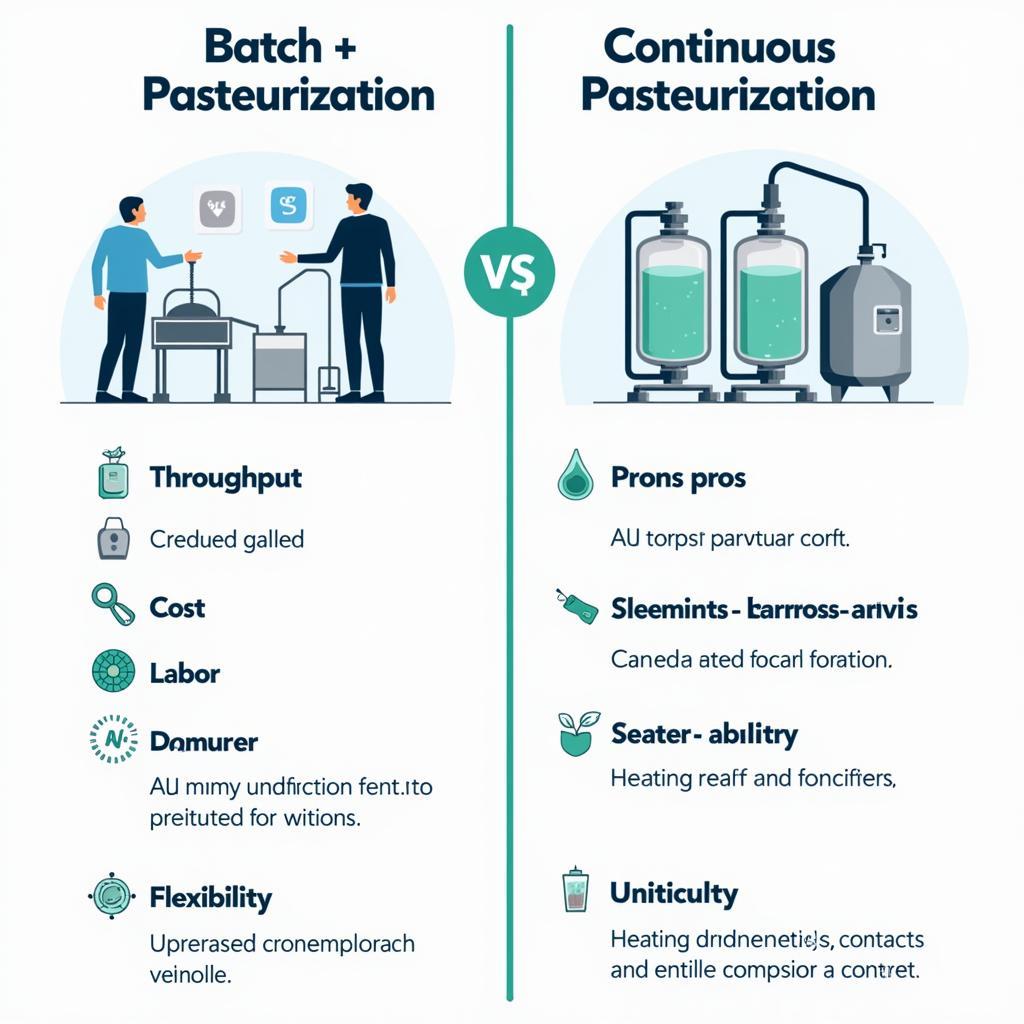Batch pasteurization and continuous pasteurization are two distinct methods used to eliminate harmful microorganisms and extend the shelf life of food and beverages, particularly milk. Understanding the differences between these two processes is crucial for choosing the most suitable method for your specific needs.
Understanding Batch Pasteurization
Batch pasteurization, also known as vat pasteurization, involves heating a specific quantity of product in a vat to a predetermined temperature for a set period. This traditional method is often preferred for smaller-scale operations or for products with specific texture or flavor requirements. The temperature and holding time vary depending on the product being pasteurized, but a common example for milk is heating to 63°C (145°F) for 30 minutes. After the holding time, the product is cooled rapidly to prevent further bacterial growth.
Advantages of Batch Pasteurization
- Simple Operation: Batch pasteurization requires less complex equipment and is easier to operate, making it ideal for smaller businesses or startups.
- Flexibility: This method allows for greater flexibility in processing different products or smaller batches.
- Lower Initial Investment: The equipment cost for batch pasteurization is generally lower than that of continuous systems.
Disadvantages of Batch Pasteurization
- Lower Throughput: Batch pasteurization is inherently slower than continuous pasteurization, limiting production capacity.
- Higher Labor Costs: The process requires more manual intervention, leading to increased labor costs.
- Potential for Uneven Heating: Achieving uniform heating throughout the vat can be challenging, especially for larger batches.
Exploring Continuous Pasteurization
Continuous pasteurization involves constantly flowing the product through a heat exchanger where it is heated to the required temperature for a specific duration. This automated process is favored by large-scale producers due to its efficiency and high throughput. A common example for milk using this method is heating to 72°C (161°F) for 15 seconds, also known as High-Temperature Short-Time (HTST) pasteurization.
Advantages of Continuous Pasteurization
- High Throughput: Continuous pasteurization can handle large volumes of product efficiently, maximizing production capacity.
- Automated Process: Automation reduces labor costs and minimizes the risk of human error.
- Uniform Heating: The continuous flow ensures consistent and uniform heating of the product.
Disadvantages of Continuous Pasteurization
- Higher Initial Investment: Continuous pasteurization systems require a significant upfront investment in specialized equipment.
- Less Flexibility: Switching between different products or adjusting batch sizes can be more complex and time-consuming.
- Complex Operation: The system requires skilled operators and regular maintenance to ensure optimal performance.
Batch Pasteurization vs Continuous Pasteurization: A Direct Comparison
| Feature | Batch Pasteurization | Continuous Pasteurization |
|---|---|---|
| Throughput | Low | High |
| Cost (Initial) | Low | High |
| Labor | High | Low |
| Flexibility | High | Low |
| Heating Uniformity | Lower | Higher |
“For small-scale operations focusing on specialized products, batch pasteurization offers a cost-effective and flexible solution,” says Dr. Nguyen Thanh Phong, a food science expert at the University of Agriculture and Forestry, Ho Chi Minh City. “However, for large-scale production where efficiency and high throughput are paramount, continuous pasteurization is the preferred choice.”
Which Pasteurization Method is Right for You?
Choosing between batch and continuous pasteurization depends on various factors, including production volume, budget, product characteristics, and desired shelf life.  So sánh thanh trùng vát và liên tục “Understanding your specific needs and priorities is crucial for making the right decision,” adds Ms. Tran Thi Thu Huong, a food safety consultant based in Hanoi.
So sánh thanh trùng vát và liên tục “Understanding your specific needs and priorities is crucial for making the right decision,” adds Ms. Tran Thi Thu Huong, a food safety consultant based in Hanoi.
Conclusion
Both batch pasteurization and continuous pasteurization are effective methods for ensuring food safety and extending shelf life. By carefully considering your specific requirements and weighing the advantages and disadvantages of each method, you can choose the optimal approach for your business and achieve your desired outcomes.
FAQ
- What is the main difference between batch and continuous pasteurization?
- Which method is more suitable for small-scale producers?
- What are the advantages of continuous pasteurization?
- Which method offers greater flexibility in processing different products?
- How does the cost of equipment differ between the two methods?
- What is HTST pasteurization?
- Which method ensures more uniform heating of the product?
Kêu gọi hành động: Khi cần hỗ trợ hãy liên hệ Số Điện Thoại: 02838172459, Email: truyenthongbongda@gmail.com Hoặc đến địa chỉ: 596 Đ. Hậu Giang, P.12, Quận 6, Hồ Chí Minh 70000, Việt Nam. Chúng tôi có đội ngũ chăm sóc khách hàng 24/7.